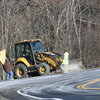Dutch barn being relocated, leaving behind only its written history
HILLTOWNS — The naked posts and beams poking up from what remains of the Shultes-Malcolm barn in Knox suggest little to the untrained eye, save for the fact that the community has come a long way from its agricultural roots.
However, those hand-hewn timbers make up the backbone of a prized and vanishing aspect of local history, built by the Dutch in the late 18th and early 19th centuries, before the Industrial Revolution.
Dutch barns are an architectural marvel for their boxy footprint and low-slung walls that do less to support the weight of the structure than the enormous beams within, so much so that the Nellis Brothers — Corey and Justin, of Fort Plain New York — have made their living in brokering the sales of these barns and carefully deconstructing them so that they can live on in more hospitable parts of the country.
Corey Nellis told The Enterprise this week that he had arranged the sale of the Malcolm-Shultes barn, along with its twin on Bradt Hollow Road, and a third barn in New Jersey, to an agricultural businessman in Nebraska, who, motivated by his own appreciation of the Dutch style, will maintain the three barns as office spaces.
Maintaining the barns on site isn’t always possible, both because they’re “always in a wet, swampy marshland,” and it costs a lot of money, Nellis said.
“It’ll be rebuilt in a better spot, and it’s … going to last another 200 years without doing anything to it,” he said of the relocation and rebuilding process.
Rebuilding the barns is easy, since they fit together “like a puzzle,” Nellis said, but they require care to take apart without stressing and breaking the lumber.
He described it as a rare art form practiced by just three companies in New York state to his knowledge, including his.
Nellis said that his family were Dutch-German settlers who came to the New World in 1640, establishing what is now the village of Nelliston. As Dutch-Germans, “they had a lot to do with … building the Dutch barns and stuff like that.”
However, he said that his decision to go into barn salvage and restorations was a “coincidence.”
Learning the skill required “a lot of research,” Nellis said, since so few people know much about Dutch barns, of which he says there’s fewer than 600 left in the country.
Nellis said that he won’t be handling the rebuild in Nebraska, but that the barns will be put back together as they were originally constructed. And since they’ll be an office space, he added, they will be more accessible than if they were turned into homes, which is often the fate of relocated barns.
According to the former Dutch Barn Preservation Society — now called the The Society for the Preservation of Hudson Valley Vernacular Architecture — the Shultes-Malcolm barn at 2233 Helderberg Trail and its accompanying farm buildings were, for the most part, built in the early 19th Century, with an English barn conjoined to the Dutch portion later on.
The group based its estimation on the barn’s relatively large size — 45 by 60 feet — which suggests that it was built after the Revolutionary War, and the barely protruding anchor beam joints push it to the years between 1820 and 1840.
The barn is named for the Shultes family (their name spelled different ways over the years), who became indentured to Stephen Van Rensselaer in 1792, preservation society member Ned Pratt wrote in a 2008 newsletter about the barn.
William and Catherine Shultes “were presumably still living at their earlier farm until Catherine’s death in 1798,” Pratt wrote. “If William got his lease on the current farm in 1792, he might have started by building a barn, but it seems more likely that his first big project was the house he built for his new wife in 1800.
“William himself died in 1808, so if the barn was constructed sometime between 1810 and 1840 it was constructed either for John Champenois, or for William’s sons, who took over the farm in about 1830.”
According to William Dietz, in the same newsletter, the Shulteses primarily grew wheat and oats, and the barn, as a consequence, “has evidence of a granary room, the original threshing floor has been preserved, and the second anchor beam has a center hole for a pole to guide horses around to separate shaft from grain.”
The farm was purchased by John D. Haverly in 1867, Dietz wrote; as a “gentleman farmer,” Haverly raised horses, while his descendents produced lumber, cattle, and apple products.
According to Dietz, the farm stayed in the Haverly family until 1964, eventually landing under the ownership of Kenneth and Pamela Malcolm from whom the barn gets its second name.
A deed shows that Kenneth Malcolm deeded the property to Charles W. Judeman Jr. and John Musco, of Schenectady, in 2016, after granting them power of attorney. Judeman died in October 2022, and Musco could not be reached. A third man under the property on the town’s assessment roll, attorney Carl Hasselbarth, also could not be reached by The Enterprise.
Hasselbarth was designated as a trustee of Malcolm's irrevocable trust in 2016.
Nellis said that the ownership situation was “chaotic,” but that the property the barn sits on is still within the Malcolm family.
Were the barn just a little further down the road, over the line in Berne, it would have been subject to that state’s historic preservation program, which Berne had enacted in the early 2000s at the behest of former town supervisor Kevin Crosier, who himself owns a Dutch barn.
The program, known as the historic homeownership rehabilitation credit, grants an income tax credit equal to 20 percent of the rehabilitation expenses for qualifying historic homes. Crosier said the program is meant to prevent the continued loss of significant buildings like the Shultes-Malcolm barn.
“Like many other symbols of our agricultural past, Dutch barns are rapidly disappearing,” the Dutch Barn Preservation Society writes on its website. “Losses are resulting from the deterioration and collapse of abandoned barns, fires, the sale and removal of historic barns in whole or as parts for the construction of contemporary buildings and the outright demolition of these barns due to obsolescence or new development. If the present trend continues unchecked, few of these venerable buildings will survive the next twenty years."
While some may bemoan the relocation, and the loss of the barns from the towns they were built in, Nellis reiterated that they’ll last longer in Nebraska, where they’ll be away from snow plows and other street traffic that damage the exteriors, and contribute to interior rotting, in addition to being accurately rebuilt in the original style.
“This is a very thorough historic restoration that will be done …,” Nellis said. “We’re trying to do the right thing. Unfortunately, we’re not affiliated with a historical society, but it’s going to the right place. It’s going to be appreciated.”



